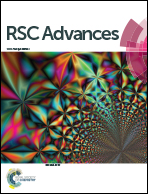Electric cell–substrate impedance sensing technique to monitor cellular behaviours of cancer cells†
Abstract
The present work reports the cellular electrical behaviour of the MDA-MB-231 breast cancer cell line treated with the anticancer drug ZD6474, using impedance sensing devices. Microelectrode-based devices with four different electrode geometries are fabricated by microfabrication technology. Real-time impedance monitoring data show high impedance variation during the initial 5 hours, revealing rapid spreading of cells over electrode surfaces. It is further established that impedance variation is mostly controlled by cells covering the electrode surface area, and thus, an enhanced effect is seen with electrode devices with a smaller geometry. Real-time impedimetric cytotoxicity data reveal that cell death and detachment starts at 21 h after inoculation of cells in the devices. The frequency response characteristics of drug-treated cells are studied to evaluate the cytotoxic effect of ZD6474. Compared to the control, a significant variation in the magnitude of the measured impedance data is observed for drug-treated samples above a 5 μM dose, indicating cell growth suppression and cell death. Finally, an empirical relationship between cell impedance and drug dose is established from impedance data, which shows that they are negatively correlated.


 Please wait while we load your content...
Please wait while we load your content...